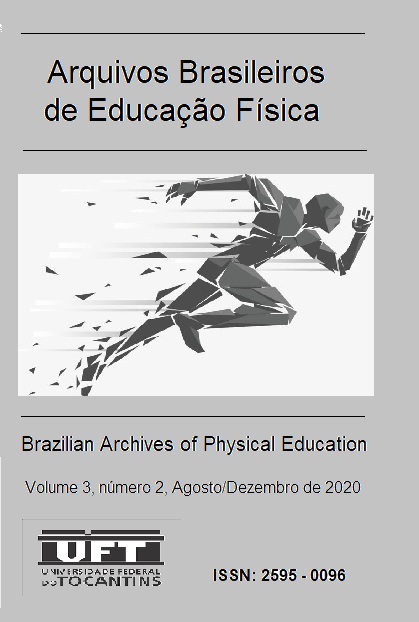Existem diferenças nas respostas perceptuais ao treinamento de força em membros superiores e inferiores?
Respostas perceptuais em membros superiores e inferiores
DOI:
https://doi.org/10.20873/10.20873/abef.2595-0096.v2n2p3949.2020Keywords:
physical effort, weight perception, strength training, training loadsAbstract
O objetivo do estudo foi comparar as respostas perceptuais ao treinamento de força em membros superiores e inferiores. Foram selecionadas 12 mulheres (idade = 23.8±5.1 anos; massa corporal = 60.1±8.2 kg; percentual de gordura = 23.5±4.7%) com experiência prévia em treinamento de força. Os sujeitos foram submetidos a realização de séries de 5 repetições com 40%, 60% e 80% de 1RM no Supino, Leg Press, Rosca Direta e Cadeira Extensora, em dias diferentes. Após realização de cada série, o esforço percebido foi coletado utilizando a escala OMNI-RES. Não foram encontradas diferenças significativas entre as intensidades impostas e entre as distintas naturezas biomecânicas dos exercícios, portanto, não há diferenças nas respostas perceptuais entre membros superiores e inferiores. Em adição, a escala OMNI-RES é eficiente ferramenta para controle de cargas fisiológicas (externas e internas) para membros superiores e inferiores em mulheres.
References
VIGITEL. Vigilância De Fatores De Risco E Proteção Para Doenças Crônicas Por Inquérito Telefônico. Bras Ministério da Saúde Secr Vigilância em Saúde Vigitel Bras 2014. 2015;
Kraemer WJ, Adams K, Cafarelli E, Dudley GA, Dooly C, Feigenbaum MS, et al. Progression models in resistance training for healthy adults. Med Sci Sport Exerc. 2002;34(2):364–80.
LeSuer DA, McCormick JH, Mayhew JL, Wasserstein RL, Arnold MD. The accuracy of prediction equations for estimating 1-RM performance in the bench press, squat, and deadlift. J Strength Cond Res. 1997;11(4):211–3.
Tiggemann CL, Korzenowski AL, Brentano MA, Tartaruga MP, Alberton CL, Kruel LFM. Perceived exertion in different strength exercise loads in sedentary, active, and trained adults. J Strength Cond Res. 2010;24(8):2032–41.
ADAMS KJ, Swank AM, Barnard KL, Berning JM, Sevene-Adams PG. Safety of maximal power, strength, and endurance testing in older African American women. J Strength Cond Res. 2000;14(3):254–60.
Pollock ML, Carroll JF, Graves JE, Leggett SH, Braith RW, Limacher M, et al. Injuries and adherence to walk/jog and resistance training programs in the elderly. Med Sci Sports Exerc. 1991;23(10):1194–200.
Scherr J, Wolfarth B, Christle JW, Pressler A, Wagenpfeil S, Halle M. Associations between Borg rating of perceived exertion and physiological measures of exercise intensity. Eur J Appl Physiol. 2013;113(1):147–55.
Gearhart JRF, Goss FL, Lagally KM, Jakicic JM, Gallagher J, Gallagher KI, et al. Ratings of perceived exertion in active muscle during high-intensity and low-intensity resistance exercise. J Strength Cond Res. 2002;16(1):87–91.
Lagally KM, Mccaw ST, Young GT, Medema HC, Thomas DQ. Ratings of perceived exertion and muscle activity during the bench press exercise in recreational and novice lifters. J Strength Cond Res. 2004;18(2):359–64.
Gentil P, Fisher J, Steele J. A review of the acute effects and long-term adaptations of single-and multi-joint exercises during resistance training. Sport Med. 2017;47(5):843–55.
Borresen J, Lambert MI. The quantification of training load, the training response and the effect on performance. Sport Med. 2009;39(9):779–95.
Tiggemann CL, Pinto RS, Kruel LFM. A percepção de esforço no treinamento de força. Rev Bras Med do esporte, São Paulo SBME Vol 16, n 4 (jul/ago 2010), p 301-309. 2010;
Heyward V. ASEP methods recommendation: body composition assessment. J Exerc Physiol Online. 2001;4(4).
Jackson AS, Pollock ML, Ward A. Generalized equations for predicting body density of women. Med Sci Sports Exerc. 1980;
William E. Siri. Body Composition From Fluid Spaces and Density: Analysis of Methods. Adv Biol Med Phy. 1956;
Brown LE, Weir JP. ASEP procedures recommendation I: accurate assessment of muscular strength and power. J Exerc Physiol Online. 2001;4(3).
Baechle TR, Earle RW. Essentials of strength training and conditioning. Human kinetics; 2008.
Robertson RJ, Goss FL, Rutkowski J, Lenz B, Dixon C, Timmer J, et al. Concurrent validation of the OMNI perceived exertion scale for resistance exercise. Med Sci Sport Exerc. 2003;35(2):333–41.
Monteiro W, Simão R, Farinatti P. Manipulacion en el orden de los ejercicios y su influencia sobre el número de repeticiones y la percepcion subjetiva del esfuerzo en mujeres entrenadas. Rev Bras Med do Esporte. 2005;11(2):146–50.
Naclerio F, Rodr’iguez-Romo G, Barriopedro-Moro MI, Jiménez A, Alvar BA, Triplett NT. Control of resistance training intensity by the OMNI perceived exertion scale. J Strength Cond Res. 2011;25(7):1879–88.
Glass SC, Stanton DR. Self-selected resistance training intensity in novice weightlifters. J Strength Cond Res. 2004;
Pritchett RC, Green JM, Wickwire PJ, Kovacs MS. Acute and session RPE responses during resistance training: Bouts to failure at 60% and 90% of 1RM. South African J Sport Med. 2009;21(1).
Looney DP, Kraemer WJ, Joseph MF, Comstock BA, Denegar CR, Flanagan SD, et al. Electromyographical and perceptual responses to different resistance intensities in a squat protocol: does performing sets to failure with light loads produce the same activity? J Strength Cond Res. 2016;30(3):792–9.
Tiggemann CL. Comportamento da percepção de esforço em diferentes cargas de exerc{’i}cios de força em adultos sedentários, ativos e treinados. 2007;
Fink J, Schoenfeld BJ, Kikuchi N, Nakazato K. Effects of drop set resistance training on acute stress indicators and long-term muscle hypertrophy and strength. J Sports Med Phys Fitness. 2018;58(5):597–605.
Downloads
Published
How to Cite
Issue
Section
License
Proposal for Copyright Notice Creative Commons
1. Policy Proposal to Open Access Journals
Authors who publish with this journal agree to the following terms:
A. Authors retain copyright and grant the journal right of first publication with the work simultaneously licensed under the Creative Commons Attribution License that allows sharing the work with recognition of its initial publication in this journal.
B. Authors are able to take on additional contracts separately, non-exclusive distribution of the version of the paper published in this journal (ex .: publish in an institutional repository or as a book), with an acknowledgment of its initial publication in this journal.
C. Authors are permitted and encouraged to post their work online (eg .: in institutional repositories or on their website) at any point before or during the editorial process, as it can lead to productive exchanges, as well as increase the impact and the citation of published work (See the Effect of Open Access).

